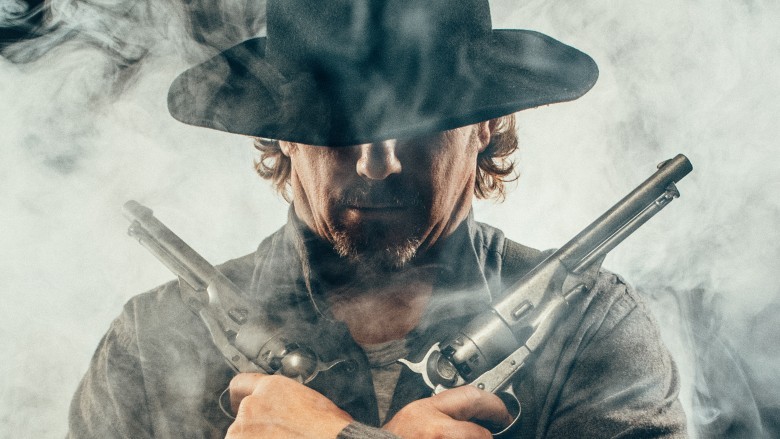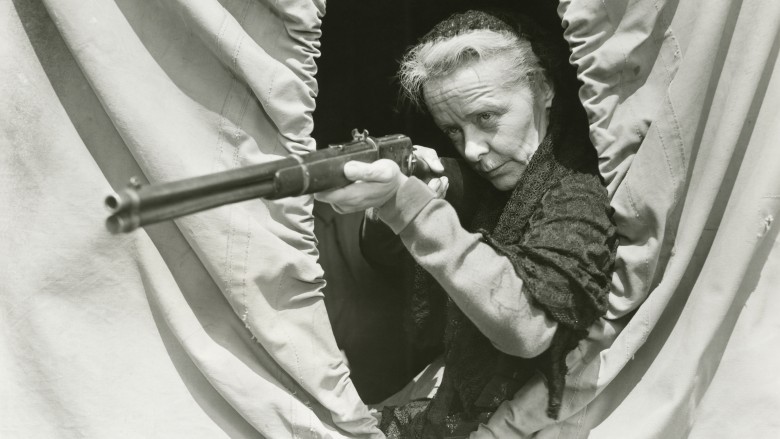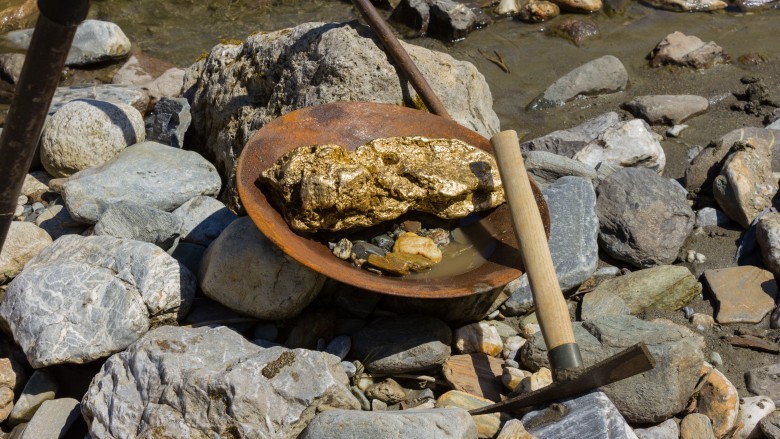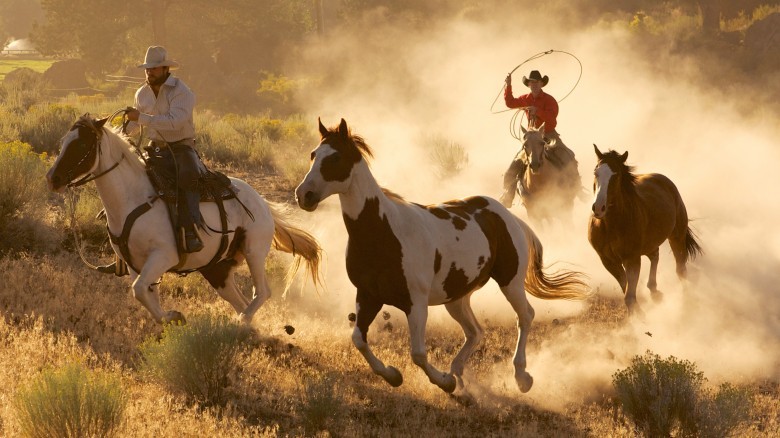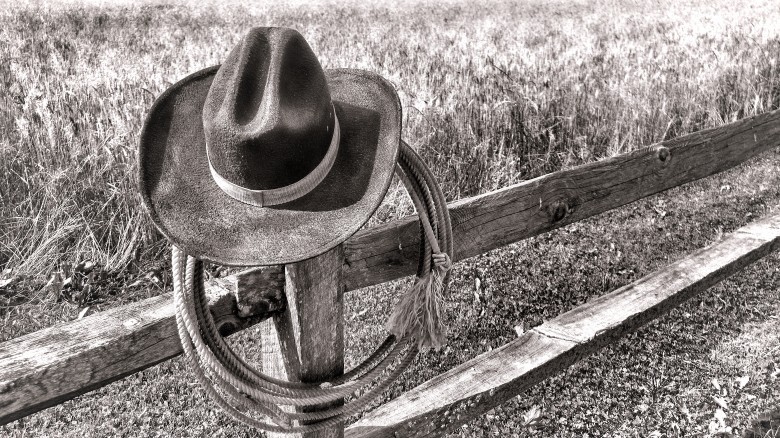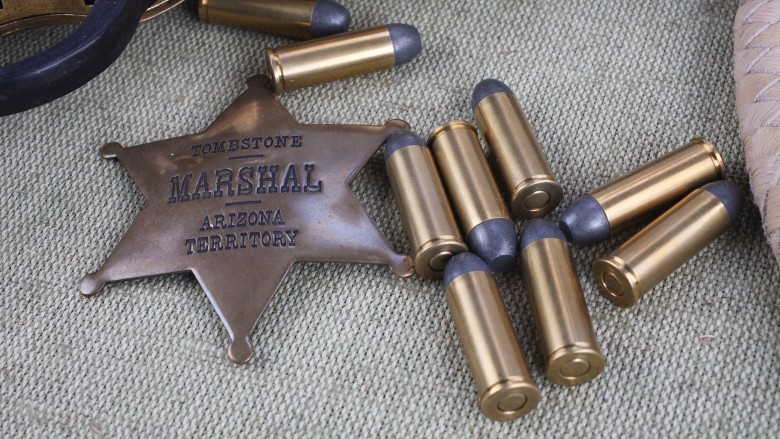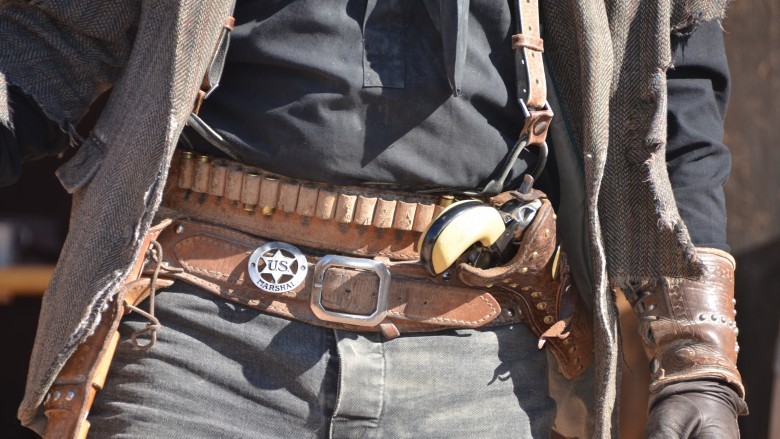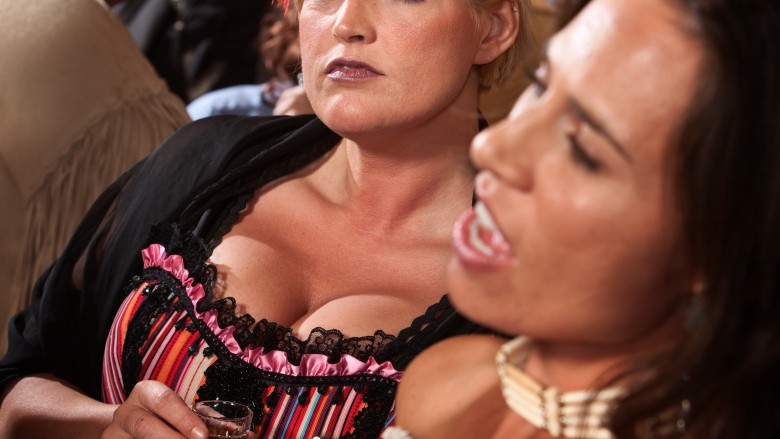False Facts About The Wild West You Always Thought Were True
If you travel to any foreign country and ask someone there what they know about American history, they will undoubtedly bring up cowboys, Indians, shootouts, and other wild west stereotypes. (Trust us—we know from experience.) Stories of the Wild West aren't just popular abroad, but domestically, too, with the likes of ultra-popular video game Red Dead Redemption, HBO series Westworld, and Quentin Tarantino's dialogue-filled, everybody-dies film The Hateful Eight all informing the most recent generation of Western fans.
Yes, the Wild West was—and still is—awesome, but that's not to say it was as awesome as video games, television, and film make it out to be. There's a lot of false facts about the old west out there in the wild, and we're here to run 'em down, tie 'em up, and leave 'em on the train tracks, like the dastardly myth-busters we are.
Myth: Native Americans were a constant threat to settlers
You'd be forgiven for thinking that those who settled the untamed western lands lived in constant fear of Native Americans. Just pop in any famous Western movie, sit back, and watch the arrows fly. Truth is, the Native Americans weren't as hostile to those covered wagon travelers as most people believe.
Though some native tribes were known to steal from settlers traveling westward through their lands, attacks and theft were few and far between, according to the National Oregon/California Trail Center at Montpelier, Idaho. While some violent altercations naturally took place, convoys of covered wagons rarely came under attack—only stragglers ran any real risk, as lone wagons or small groups represented much easier pickings. In reality, many friendly tribes saw groups of settlers as prime trade opportunities, exchanging "buffalo robes and moccasins for knives, clothes, food, and other items."
Ultimately, the threat from Indian attack was minimal at best. According to Keith Heyer Meldahl's Hard Road West: History and Geology Along the Gold Rush Trail, Native Americans killed—on record—362 migrants between 1840 and 1860. Compare this number to the upward of 30,000 total migrants who died from all causes during the same 20-year span, and it becomes clear that Indians were the least of anyone on the trail's concerns, accounting for as low as 1 percent of all fatalities. Truth be told, more Native Americans died at the hands of migrants than vice versa, though the number is comparable, at 426 deaths.
So the next time someone tells you to "circle the wagons," ask them what for?
Myth: California was the site of the first gold rush
It is commonly believed that California hosted America's first gold rush, what with popular film depictions, the NFL's San Francisco 49ers, and the fact that California is called "the freakin' Golden State." But wouldn't you know it, California was not the first gold rush? Heck, it wasn't even the second!
Fifty years before some gold nuggets at Sutter's California mill triggered the largest mass migration in US history, a 17-pound chunk of the precious metal was discovered in Cabarrus County, North Carolina, leading to a flood of more than 30,000 prospectors and the Tar Heel state's 30-year reign as the champions of American gold. The initial discovery by 12-year-old North Carolinian Conrad Reed is indeed the first authenticated discovery of gold in the United States, sparking the first American gold rush—before people even really knew how to effectively get the stuff out of the ground.
The great state of Georgia holds claim to America's second gold rush, though nobody really knows who discovered the shiny metal there first. There are some anecdotal reports of various individuals stumbling upon the magnificent ore, but it wasn't until the Georgia Journal printed the following notice that the discovery of gold in the state went on record: "GOLD.—A gentleman of the first respectability in Habersham county, writes us thus under date of 22d July: 'Two gold mines have just been discovered in this county, and preparations are making to bring these hidden treasures of the earth to use.' So it appears that what we long anticipated has come to pass at last, namely, that the gold region of North and South Carolina, would be found to extend into Georgia." Only a few months later, northern Georgia was overrun by those hopeful of striking it rich—despite the protests of the Cherokee Nation—causing the second gold rush in American history to go down in history as "The Great Intrusion."
California would have its turn, but it had to wait for patiently for its Appalachian cousins to run their course. The West may be the best, but everything happens in the East first—at least to the tune of a few hours.
Myth: Cowboys were originally white Americans
Cowboys are about as American as baseball and apple pie, right? They're one half of the phrase "cowboys and Indians"—and everyone knows "cowboys and Indians" is the copyrighted property of the US of freakin' A, baby! Yeeee haw!
Unfortunately for anybody who's that gung-ho over cowboys, the stereotypical image of the cattle wranglers as a white, distinctly American invention is just plain false. For starters, the origins of the cowboy lie in the union of Anglo and Hispanic cultures—married in the great state of Texas—with everything from their clothing, to their language, to the food they ate owing loads and loads to Mexico. In fact, the deepest roots of the cowboy date back to the arrival in Mexico of the Spanish, who built ranches. Trained ranchers—called vaqueros—became a necessity, and as ranches spread across modern-day Texas, Arizona, and New Mexico, so too did the vaqueros, laying claim to the title of America's first cowboys.
Secondly, decades of film and television have conditioned us to incorrectly think that all cowboys were white, when, in fact, upward of 25 percent of cowboys were black—while even more were Mexican. As thousands of people migrated to Texas in search of cheap land, so too did the land-owners' slaves, a vital part of maintaining many new cattle ranches across the Lone Star State. And although the Civil War didn't ultimately have that much to do with Texas, many landowning Texans fought, creating even an even greater need for skilled African-American cowboys to replace them.
Myth: Cowboy hats were all the rage in the Wild West
It's common knowledge that everyone in the Wild West was rockin' a Stetson hat, commonly known as a cowboy hat. It was surely the height of fashion and the covering of choice for Miss Manifest Destiny, herself. Right?
Wrong! Truth is, cowboy hats—at least as we envision them, or as everyone in today's Texas seems to wear—were ultimately not very popular. Hats in general, however, were all the rage, with the bowler hat being the hat of choice for cowboys, or anyone with any shred of class, for that matter. Originally associated with London businessmen, the bowler was the most popular hat in America during the late 1800s and was a fashion essential, much like the flat-brimmed Phillies baseball cap for Bloomsburg University freshmen trying to fit in.
Sometimes a good bowler just isn't enough, though, like when you're out on the plains, herding cattle for weeks on end. Enter Stetson's "Boss of the Plains" hat, which equates to the true cowboy hat of the time. It was, like a modern cowboy hat, rugged, durable, and waterproof but was shaped much differently, with a sharper cylindrical shape sitting atop a perfect-circle brim, not unlike a modern-day Amish hat. Regardless of whether cowboy hats suit your tastes, it's hard to deny this early variant was significantly less stylish, lacking the dimpled top and upward-curving brim.
A message to all the cowboy hat-sporting Texans down there: bring back the Boss of the Plains! At the very least, Stetson earns major points there for the most badass hat name ever created.
Myth: The Wild West was lawless and full of bank robberies
According to nearly every Western ever made, the Wild West was just that—wild. Bandits rode squad deep through ramshackle towns, dragging people behind their horses. Bank robberies were about as common as hitting up the local ATM. People were getting shot in saloons on a nightly basis. Lawlessness just came with the territory. But while this image is good for the moving pictures, it ain't so good in terms of historical accuracy.
Let's start with bank robberies. According to popular belief, it would seem safer to just keep your money buried somewhere under a cactus than in a bank. In reality, banks were very safe spaces to keep your valuables—perhaps even safer than banks today. According to Larry Schweikart at the Foundation for Economic Freedom, there were only eight confirmed bank robberies total from 1859 to 1900. As Schweikart points out, "There are more bank robberies in modern-day Dayton, Ohio, in a year than there were in the entire Old West in a decade, perhaps in the entire frontier, period!" Remind us never to store our money in Dayton.
The Wild West wasn't even that wild. The law was highly abided in the untamed lands. According to the Mises Institute, "property rights were protected, and civil order prevailed"—thank to private agencies that "provided the necessary basis for an orderly society in which property was protected and conflicts were resolved," such as organized "land clubs, cattlemen's associations, mining camps and wagon trains." Historian W. Eugene Hollon claims the west "was a far more civilized, more peaceful and safer place than American society today," as violence was not so culturally ingrained as popular history leads us to believe. In fact, if we really wish to speak of violence in the Old West, we must speak about its real source: the federal government's policies against the Plains Indians.
All things considered, you were probably better off storing your money with Alma Garrett and residing in Deadwood than walking the streets of modern-day Chicago!
Myth: Everyone was packing heat in the Wild West
Everyone in the Wild West—and we mean everyone—had a six shooter at their hip. Surely that's one fact that can't be false, right? According to every Western we've ever seen, your average town had more guns than a well-stocked Walmart in Tennessee.
Well, damn it all! Would you believe that the west had potentially stricter gun laws than many states today? In the words of author Robert R. Dykstra, "the uniquely savage and homicide-ravaged Old West is a construct as phony as America's favorite 'invented tradition'—the quick-draw street duel reenacted every day in a score of tourist venues." In reality, property-owners and ranchers all over called for tight restrictions on firearms, with the knowledge that more guns—in the wrong hands—meant more problems.
Loads of western towns did take action, the most famous being Dodge City, Kansas, which proudly displayed a massive sign in the middle of town, reading: "The carrying of Firearms Strictly Prohibited." Wichita, Kansas greeted visitors, in 1873, with a sign, declaring: "Leave Your Revolvers At Police Headquarters, and Get a Check." In fact, according to Adam Winkler, "frontier towns—places like Tombstone, Deadwood, and Dodge—had the most restrictive gun control laws in the nation," laws that would make some second-amendment advocates in today's America weep. In many places, even sharpshootin' cowboys weren't even allowed to carry guns, as they were told that carrying around a six-shooter was not a necessary part of their jobs, with Kansas newspaper the Caldwell Commercial calling revolvers "a relic of barbarism."
When it comes to guns, today's America is the real Wild West, with the FBI reporting 8,124 gunshot deaths in 2014.
Myth: Prostitutes had it rough
We've all seen Deadwood. We all know Trixie. We know that 19th-century prostitutes had a rough life, subject to abuse, poor personal hygiene and the whims of their employer. At least, this was the common perception, until Thaddeus Russell published A Renegade History of the United States in 2010.
Back in the day, women had no real rights. Women were barely allowed to work, and those jobs they were permitted to do paid obscenely low salaries. Wives has no legal right to property and were themselves the lawful property of their husbands. Respectable women in the Wild West could not, to paraphrase Russell, own property, make high wages, have sex outside of marriage, perform or receive oral sex, use birth control, consort with men of other races, dance, drink, walk alone in public, or wear makeup, perfume, or stylish clothes—all things women are obviously allowed to do in today's American society. The only women who could do all these things, surprisingly, were prostitutes.
As described in Russell's book, madams owned some of the sweetest real estate in the Wild West, during a period in history when women owning land was virtually unheard of. Prostitutes also had the highest income of all American women, and with money comes power, so wealthy madams held great influence in the development of the west. In a time when health insurance wasn't commonplace, some madams even offered free health care to their employees, in addition to private and police protection from rowdy or dangerous clients. In terms of personal freedom, prostitutes were free from the "slavery of marriage," and were—in many ways—some of the first, true American feminists.
Some prostitutes even carried guns. So you best mind your manners.
